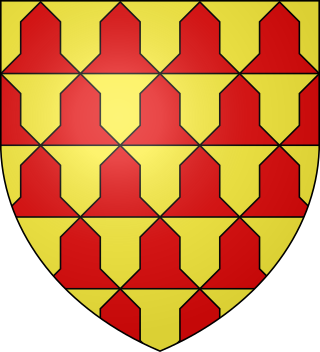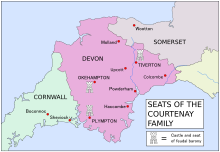
Year 1150 (MCL) was a common year starting on Sunday of the Julian calendar.

The House of Bourbon is a dynasty that originated in the Kingdom of France and is a branch of the Capetian dynasty, the royal House of France. Bourbon kings first ruled France and Navarre in the 16th century, and by the 18th century, members of the Spanish Bourbon dynasty held thrones in Spain, Naples, Sicily, and Parma. Today Spain and Luxembourg have monarchs of the House of Bourbon. The royal Bourbons originated in 1272, when Robert, the youngest son of King Louis IX of France, married the heiress of the lordship of Bourbon. The house continued for three centuries as a cadet branch, serving as nobles under the direct Capetian and Valois kings.

Earl of Devon is a title that has been created several times in the Peerage of England. It was possessed first by the Redvers family, and later by the Courtenay family. It is not to be confused with the title of Earl of Devonshire, which is held by the Duke of Devonshire, although the letters patent for the creation of the latter peerages used the same Latin words, Comes Devon(iae). It was a re-invention, if not an actual continuation, of the pre-Conquest office of Ealdorman of Devon.
Renaud de Courtenay, anglicised to Reginald I de Courtenay, of Sutton, Berkshire, was a French nobleman of the House of Courtenay who took up residence in England and founded the English Courtenay family, who became Earls of Devon in 1335. The title is still held today, by his direct male descendant.

The House of Bauffremont is the name of a French princely family which derived its name from a village in the Vosges, outside of Neufchâteau, now spelt Beaufremont. The family traces itself to Liébaud, sire de Bauffremont, in 1090. They are descended from the female line of the House of Courtenay.

William de Redvers, 5th Earl of Devon, of Tiverton Castle and Plympton Castle, both in Devon, was feudal baron of Plympton in Devon.
Boconnoc is a civil parish in Cornwall, England, United Kingdom, approximately four miles (6 km) east of the town of Lostwithiel. According to the 2011 census the parish had a population of 96.

Hugh Rupert Courtenay, 18th Earl of Devon, DL, styled as Lord Courtenay until 1998, of Powderham Castle in Devon, was a British peer, landowner, and surveyor.

The Bourbon-Busset family is a cadet branch of the House of Bourbon, being thus agnatic descendants of the Capetian dynasty. Historically, they have been regarded as non-dynastic since decisions rendered by Louis XI of France.

Sir Hugh de Courtenay, 2nd/10th Earl of Devon, 2nd Baron Courtenay, feudal baron of Okehampton and feudal baron of Plympton, played an important role in the Hundred Years War in the service of King Edward III. His chief seats were Tiverton Castle and Okehampton Castle in Devon. The ordinal number given to the early Courtenay Earls of Devon depends on whether the earldom is deemed a new creation by the letters patent granted 22 February 1334/5 or whether it is deemed a restitution of the old dignity of the de Redvers family. Authorities differ in their opinions, and thus alternative ordinal numbers exist, given here.

Sir John Courtenay was the third son of Thomas Courtenay, 13th Earl of Devon, and Margaret Beaufort, and was styled Earl of Devon by Lancastrians in exile, following the execution of his brother the 14th earl in 1461.

A prince du sang is a person legitimately descended in male line from a sovereign. The female equivalent is princess of the blood, being applied to the daughter of a prince of the blood. The most prominent examples include members of the French royal line, but the term prince of the blood has been used in other families more generally, for example among the British royal family and when referring to the Shinnōke in Japan.

Hugh de Courtenay, 1st/9th Earl of Devon of Tiverton Castle, Okehampton Castle, Plympton Castle and Colcombe Castle, all in Devon, feudal baron of Okehampton and feudal baron of Plympton, was an English nobleman. In 1335, forty-one years after the death of his second cousin once-removed Isabel de Redvers, suo jure 8th Countess of Devon he was officially declared Earl of Devon, although whether as a new creation or in succession to her is unknown, thus alternative ordinal numbers exist for this Courtenay earldom.
Sir Hugh de Courtenay (1251–1292) was the son and heir of John de Courtenay, feudal baron of Okehampton, Devon, by Isabel de Vere, daughter of Hugh de Vere, 4th Earl of Oxford. His son inherited the earldom of Devon.

The Capetian House of Courtenay, also known simply as the House of Courtenay, was a royal house and cadet branch of the direct House of Capet, also known as the Royal House of France. Founded by Peter I of Courtenay, a son of King Louis VI of France, the family drew its name from the lordship of Courtenay, to which Peter's wife was heiress.

Sir Hugh Courtenay of Boconnoc in Cornwall, was twice a Member of Parliament for Cornwall in 1446–47 and 1449–50. He was beheaded after the Battle of Tewkesbury in 1471, together with John Courtenay, 7th Earl of Devon, the grandson of his first cousin the 4th Earl, and last in the senior line, whose titles were forfeited. His son Edward Courtenay, 1st Earl of Devon, was created Earl of Devon in 1485 by King Henry VII, following the Battle of Bosworth and the closure of the Wars of the Roses.

The feudal barony of Okehampton was a very large feudal barony, the largest mediaeval fiefdom in the county of Devon, England, whose caput was Okehampton Castle and manor. It was one of eight feudal baronies in Devonshire which existed during the mediaeval era.

The feudal barony of Plympton was a large feudal barony in the county of Devon, England, whose caput was Plympton Castle and manor, Plympton. It was one of eight feudal baronies in Devonshire which existed during the medieval era. It included the so-called Honour of Christchurch in Hampshire, which was not however technically a barony. The de Redvers family, first holders of the barony, were also Lords of the Isle of Wight, which lordship was not inherited by the Courtenays, as was the barony of Plympton, as it had been sold to the king by the last in the line Isabel de Redvers, 8th Countess of Devon (1237–1293).
Jocelyn I de Courtenay, son of Athon, Châtelain de Châteaurenard, Seigneur de Courtenay. Very little is known about his life other than his two marriages. He first married Hildegarde de Château-Landon, daughter of Geoffrey II, Count of Gâtinais, and Ermengarde of Anjou. Joscelin and Hildegarde had one daughter:

















